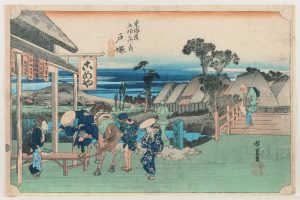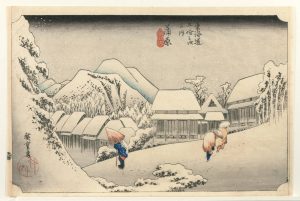
Inspiring wanderlust
Scenic prints known as meisho-e — “pictures of famous places” — had previously been considered of only secondary interest compared with bijin-ga (“pictures of beautiful women”) and yakusha-e (“actor prints”), but they later joined these subgenres as mainstays in the world of ukiyo-e. In fact, meisho-e are thought to have enjoyed more sustained, long-term sales than portraits of beauties and actors, which tended to rise and fall in popularity with the fickle fortunes of their subjects. Meisho-e depicting famous spots in Edo were snapped up as souvenirs by samurai returning to their domains after stints in the capital, and prints of scenes along the Tokaido road, the main route between Edo and Kyoto, whetted Edoites’ appetites for travel, whether real or vicarious. Foods associated with each locale tended to be included in the scenes portrayed, adding to the ways in which the prints served like today’s travel guides. The less well-to-do would buy a single print, while some better-off folk would purchase in quantity. For those with the means, complete sets comparable to expensive, lavishly produced modern-day art books could be acquired in back rooms, out of view of authorities who enforced edicts from the shogunate discouraging luxury.





